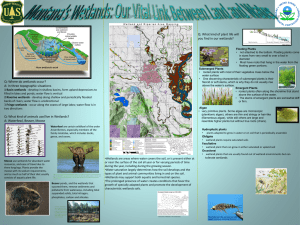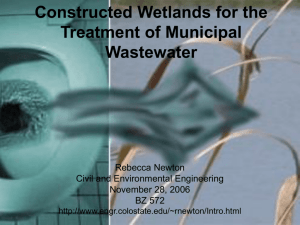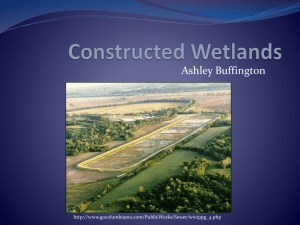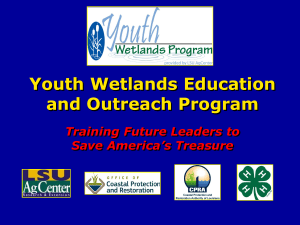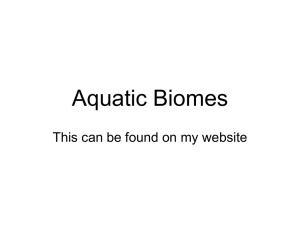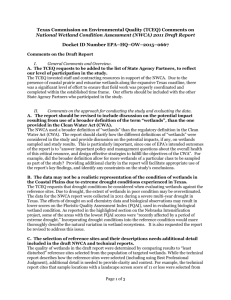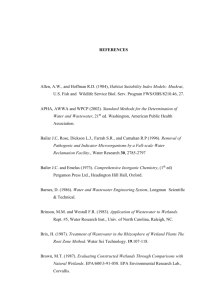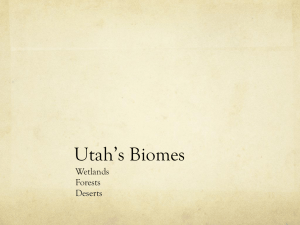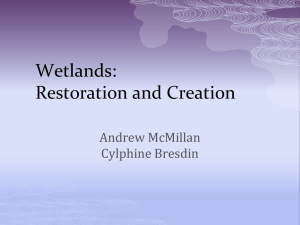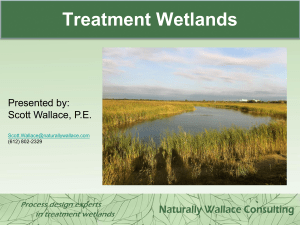Free water surface wetlands by Patrick Brice
advertisement
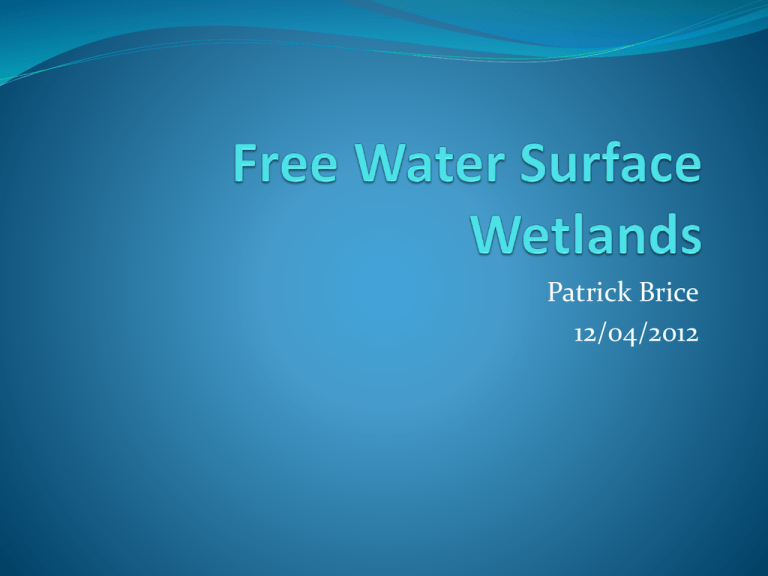
Patrick Brice 12/04/2012 Types of Free Water Surface (FWS) Wetlands Surface Flow Open Water Zone Floating Aquatic Plant System FWS: Surface Flow Free Water Surface Wetlands for Wastewater Treatment- A Technology Assessment, EPA 1999 FWS: Open Water Zone Free Water Surface Wetlands for Wastewater Treatment- A Technology Assessment, EPA 1999 FWS: Floating Aquatic Plant System Free Water Surface Wetlands for Wastewater Treatment- A Technology Assessment, EPA 1999 Question #1 Name 2 types of Free Water Surface Wetlands. Typical Elements of FWS Wetland Constructed Wetlands: Treatment of Municipal Wastewaters, EPA 2000 Design Considerations Hydraulic Retention Time 2 to 3 days in each cell (EPA 2000) Depth Surface Flow: 0.1m to 0.6m (Economopoulou and Tsihrintzis, 2004) Open Water Zone: ≥ 1.2m (EPA 2000) L:W Ratio 2:1 to 5:1 (Economopoulou and Tsihrintzis, 2004) Vegetation Porosity 0.65 to 0.75 (Reed et al., 1995) Design Considerations- Continued Influent Parameters Quantity pH BOD/COD Metals Nutrients Salinity Temp Influent Parameters Determine Final Design! Plants Used in FWS Wetlands Cattail Red Maple Soft Stem Bulrush Pickerlweed Lilies Pros and Cons Advantages Disadvantages Low construction and Large area requirements operational costs Year-round operation in all but coldest climates (EPA 2000) Provide wildlife habitat and promote biodiversity Effective for treating organics, nutrients, pathogens, and metals Effective handling of shock loads compared to conventional treatments (Schroder et al., 2007) Acts as both a sink and potential source of metals and nutrients (Kongroy et al., 2011) Removal rates lower in colder climates (Kadlec and Wallace, 2009) Potential problems with mosquito and other vector insects (Thullen et al. 2002) Question #2 What is the biggest disadvantage of a FWS? References Cameron, Kimberley, Madramootoo, Chandra, Crolla, Anna and Kinsley, Christopher. “Pollutant removal from municipal sewage lagoon effluents with a free-surface wetland.” Water Research, Volume 37, Issue 12, , July 2003, Pages 2803-2812. Davis, Luise. United States. Department of Agriculture. Constructed Wetlands Handbook. Web. <http://water.epa.gov/type/wetlands/restore/upload/constructed-wetlands-handbook.pdf>. Economopoulou, Maria, and Vassilios Tsihrintzis. Design Methodology of Free Water Surface Constructed Wetlands. Water Resources Management 18. (2004): 541-565. Print. Ibekwe, A.M., S.R. Lyon, M. Leddy, and M. Jacobson-Meyers.Impact of Plant Density and Microbial Composition on Water Quality from a Free Water Surface Constructed Wetland. Journal of Applied Microbiology.102 (2007): 921-936. Print. Kadlec, Robert H., Wallace, Scott D., Treatment Wetlands. 2nd ed. Boca Raton: Taylor & Francis Group, LLC, 2009. eBook. Porntawee Kongroy, Netnapid Tantemsapya, Ying-Feng Lin, Shuh Ren Jing & Wanpen Wirojanagud (2012): Spatial Distribution of Metals in the Constructed Wetlands, International Journal of Phytoremediation, 14:2, 128-141 Schroder, Peter, Juan Navarro-Avino, et al. "Phytoremediation Technologies." Phytoremediation Technologies. 14.7 (2007): 490-497. Reed, S. C., Crites, R. W., and Middlebrooks, E. J., Natural Systems for Waste Management and Treatment, 2nd ed. New York: McGraw-Hill, Inc, 1995. eBook. Rittman, Bruce, McCarty, Perry. “Environmental Biotechnology: Principles and Applications.” McGraw Hill. New York, NY. 2001. Rogozinski, Lynn, and Janis Farmer. "Groundwater Treatment Via Constructed Wetland." National Groundwater Association. BP Oil Company. Web. 1 Dec 2012. <http://info.ngwa.org/GWOL/pdf/920157405.PDF>. Thullen, Joan S., Sartoris, James J., and Walton, William E. “Effects of vegetation management in constructed wetland treatment cells on water quality and mosquito production.” Ecological Engineering, Volume 18, Issue 4, , 1 March 2002, Pages 441-457. United States. Environmental Protection Agency. Free Water Surface Wetlands for Wastewater Treatment. Washington D.C.: USEPA Office of Water, 1999. Web. 29 Nov 2012. <http://water.epa.gov/type/wetlands/restore/upload/2004_12_20_wetlands_pdf_FW_Surface_Wetlands.pdf > United States. Environmental Protection Agency. Orlando, FL-Wetland Treatment Systems: A Case History- The Orlando Easterly Wetland Reclamation Project. Washington D.C.: USEPA Office of Water, 1993. Web. 29 Nov 2012. <http://www.epa.gov/owow/wetlands/pdf/Orlando.pdf> United States. Environmental Protection Agency. Wastewater Technology Fact Sheet: Free Water Surface Wetlands. Washington D.C.: USEPA Office of Water, 2000. Web. 29 Nov 2012. <http://www.epa.gov/owow/wetlands/pdf/Orlando.pdf>


